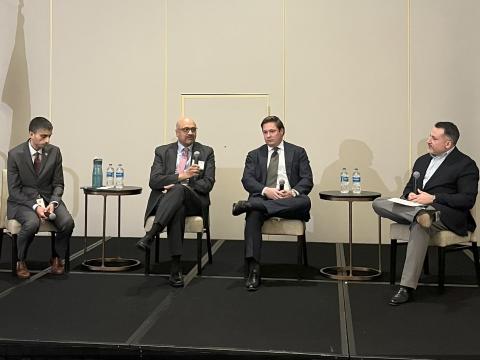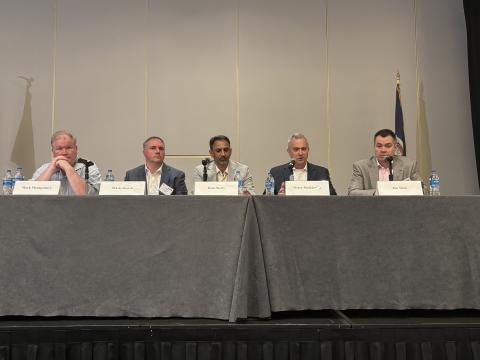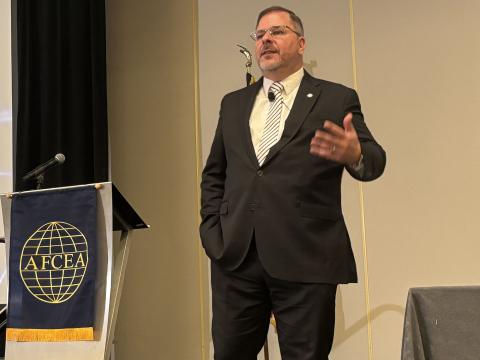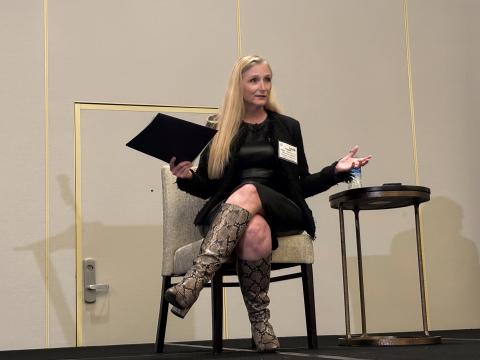Examining Management By Mouse
Understanding information technologies is key to effective command.
Placing the concept of management into a military context allows the art of both management and command and control to be examined. Both involve the same processes of sensing one’s environment, understanding one’s place and role in that environment, deciding what needs to be done and ensuring that action is carried out to achieve the intended effect. Information technology has a profound influence on these components, enabling the commander to retain the appropriate focus on the mission, improving the quality and speed of decisions, but increasing the need to take care not to be seduced by information for its own sake.
This theme was the central thrust of TechNet Europe 2002, which was held in Budapest, Hungary, October 17-18 at the Intercontinental Hotel. With representation from 28 nations, including 25 European countries, more than 500 people were able to take full advantage of a packed program of panel sessions, keynote speeches and an exhibition area with more than 30 companies participating.
The title of the event was “Management by Mouse.” Many of the speakers emphasized that the human, intellectual dimension remains as important as ever, and detailed reporting must not erode the delegation of authority and responsibility. To retain effective leadership, commanders must guard against communicating with staff and subordinates only by e-mail or by meeting via closed-circuit television. It is essential to understand the intrinsic value of the information available to the commander and to develop procedures to manage it according to its value in relation to the mission objectives.
The director of NATO’s International Military Staff, Vice Adm. Sir Paul Haddacks, KCB, RN, opened the event with a keynote speech that reflected on the effect of the use of technology on the art of management, including command and control in the operational environment. He provided up-to-date information on NATO’s current activities and predicted some of the outcomes of the Prague Summit being held in November. He emphasized the importance of training people to manage information effectively while remembering the importance of face-to-face contact.
This led appropriately to the first panel session, which explored the application of technology in the operational environment. The session included a presentation by Alec Umansky, of Defence Communications Industry, who traveled from Australia to speak. He invited the audience to join in a moment of silence to remember the terrorist bombing in Bali, Indonesia, which had killed more than 200 people five days earlier, including some personally known to him.
The day’s second panel discussed security management in the defense environment. The session included a presentation by Rear Adm. Dr. Sigurd Hess, GE N (Ret.), former AFCEA Europe general manager, on gaming techniques for the protection of information-technology-sensitive critical infrastructures.
The second keynote speech was given in the afternoon by Heinz-Peter Dicks, the general manager of the NATO Consultation, Command and Control Agency (NC3A). Dicks covered how the NC3A achieves the “best of breed” in technology to contribute to the management of NATO’s deployed forces. He emphasized the importance of close co-operation with the user throughout the development and procurement cycle and concluded with a short overview of the NC3A contribution to network-centric warfare.
Day two of the event opened with a keynote speech by Maj. Gen. Tony Raper, CBE, the director general, equipment capability, at the headquarters of the United Kingdom’s Defence Logistics Organisation (DLO). He provided insight into how the DLO is changing the way it does business to provide a more customer-focused output and using technology only where the gains are apparent and quantifiable. The following session continued with a review of the application of technology in the support environment, with speakers representing companies from the United States, the United Kingdom and Belgium.
The second session was opened by Rear Adm. Vittorio di Cecco, ITN, the J-6 at AFSOUTH, Naples, Italy, who gave an operational view on the experiences gained in deploying NATO forces with varying levels of technological capability. He emphasized the importance of interoperability and the ways in which NATO is attempting to achieve the necessary levels to conduct joint and coalition operations.
The panel that followed pondered the challenges of having too much technology. Rear Adm. “Willie” Williamson, USN (Ret.), now with Microsoft, wondered if having too much technology was a bad thing. He concluded, along with the other speakers, that strong management and intelligent users are the key to successfully harnessing technology.
The final afternoon saw the Hungarian Defense Forces (HDF) bring the audience up to date with their plans for the installation of future communications and information systems. The panel was introduced by Maj. Gen. Dr. Zoltan Szenes, HDF, director of the Defense Staff. He outlined the challenges that they are facing, and then turned the session over to Brig. Gen. János Mikita, HDF, the J-6 of the HDF, to provide the detail. Gen. Mikita explained that the legacy systems available to the HDF are being updated now that his country is a member of NATO, and he gave information on a range of projects and programs being implemented to meet NATO standards.
Bringing TechNet Europe to a close, Cdre. Robert Howell, RN (Ret.), AFCEA Europe’s general manager, noted that he was particularly pleased to see so many members of the HDF attending in uniform, clearly showing a great interest in the exhibition. In addition, 11 AFCEA chapter presidents, two regional vice presidents and seven directors attended the conference, so the strong AFCEA leadership representation also helped to guide the event. Cdre. Howell ended by expressing the hope that he would see equivalent numbers, or more, at TechNet Europe 2003 to be held in Rome, Italy, October 16-17, 2003, under the title “Internet: Friend or Foe?”




Comments